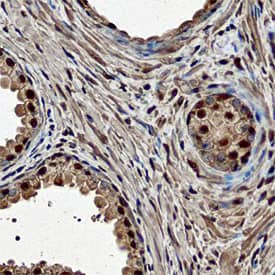Human ELF3 Antibody
R&D Systems, part of Bio-Techne | Catalog # MAB57871

Key Product Details
Validated by
Knockout/Knockdown
Species Reactivity
Human
Applications
Immunohistochemistry
Label
Unconjugated
Antibody Source
Monoclonal Mouse IgG1 Clone # 662516
Product Specifications
Immunogen
E. coli-derived recombinant human ELF3
Met1-Gly173
Accession # P78245
Met1-Gly173
Accession # P78245
Specificity
Detects human ELF3 in direct ELISAs. In direct ELISAs, no cross-reactivity with recombinant
human ELF5 is observed.
Clonality
Monoclonal
Host
Mouse
Isotype
IgG1
Scientific Data Images for Human ELF3 Antibody
ELF3 in Human Prostate.
ELF3 was detected in immersion fixed paraffin-embedded sections of human prostate using Mouse Anti-Human ELF3 Monoclonal Antibody (Catalog # MAB57871) at 15 µg/mL overnight at 4 °C. Before incubation with the primary antibody, tissue was subjected to heat-induced epitope retrieval using Antigen Retrieval Reagent-Basic (Catalog # CTS013). Tissue was stained using the Anti-Mouse HRP-DAB Cell & Tissue Staining Kit (brown; Catalog # CTS002) and counterstained with hematoxylin (blue). Specific staining was localized to nuclei of glandular epithelial cells. View our protocol for Chromogenic IHC Staining of Paraffin-embedded Tissue Sections.Detection of Human ELF3/ESE-1 by Immunohistochemistry
ELF3, EHF, and TGIF1 enhances the malignant phenotypes of LUAD cells.A, B Inhibition of invasive and migrate activity by knockdown master TFs, ELF3, EHF, and TGIF1. PC-9 cells were transfected with indicated siRNA-pool and subjected to invasion and migration assays (see “Materials and methods”). Invaded and migrated cells were stained with crystal violet and counted (see Fig. S3). Histograms represent the number of invasion or migration. Representative photographs were shown. C Colony assay performed on PC-9 cells transfected with either scramble or siRNA-pool targeting ELF3, EHF, and TGIF1. D Silencing of ELF3, EHF, and TGIF1 increased clonal cell growth in a 3D spheroid culture system. PC-9 cells transfected with scramble or siRNA-pool were cultured as spheroid in DMEM medium and the spheroids was observed after 48 h. E Inhibition of cell migration by knockdown master TFs, ELF3, EHF, and TGIF1. PC-9 cells were transfected with indicated siRNA-pool and subjected to scratch assay (see “Materials and methods”). Representative photographs were taken and migration areas were measured. Statistical analysis was performed by using t tests; data are shown as bar graphs of the mean ± SD. of three independent experiments. Scale bars (white) indicate 250 μm. F The effects of pcDNA3.1-ELF3 and/or pcDNA3.1-EHF co-transfected with TGIF1 siRNA on cell migration and invasiveness in LUAD cells were examined by Transwell assays using a Boyden chamber in the presence or absence of Matrigel, respectively. Histograms represent the number of invasion or migration. Data were representative of two to three separate experiments performed in triplicate. *p < 0.05; **p < 0.01; ***p < 0.001. Image collected and cropped by CiteAb from the following publication (https://pubmed.ncbi.nlm.nih.gov/33070167), licensed under a CC-BY license. Not internally tested by R&D Systems.Detection of Human ELF3/ESE-1 by Immunohistochemistry
ELF3, EHF, and TGIF1 enhances the malignant phenotypes of LUAD cells.A, B Inhibition of invasive and migrate activity by knockdown master TFs, ELF3, EHF, and TGIF1. PC-9 cells were transfected with indicated siRNA-pool and subjected to invasion and migration assays (see “Materials and methods”). Invaded and migrated cells were stained with crystal violet and counted (see Fig. S3). Histograms represent the number of invasion or migration. Representative photographs were shown. C Colony assay performed on PC-9 cells transfected with either scramble or siRNA-pool targeting ELF3, EHF, and TGIF1. D Silencing of ELF3, EHF, and TGIF1 increased clonal cell growth in a 3D spheroid culture system. PC-9 cells transfected with scramble or siRNA-pool were cultured as spheroid in DMEM medium and the spheroids was observed after 48 h. E Inhibition of cell migration by knockdown master TFs, ELF3, EHF, and TGIF1. PC-9 cells were transfected with indicated siRNA-pool and subjected to scratch assay (see “Materials and methods”). Representative photographs were taken and migration areas were measured. Statistical analysis was performed by using t tests; data are shown as bar graphs of the mean ± SD. of three independent experiments. Scale bars (white) indicate 250 μm. F The effects of pcDNA3.1-ELF3 and/or pcDNA3.1-EHF co-transfected with TGIF1 siRNA on cell migration and invasiveness in LUAD cells were examined by Transwell assays using a Boyden chamber in the presence or absence of Matrigel, respectively. Histograms represent the number of invasion or migration. Data were representative of two to three separate experiments performed in triplicate. *p < 0.05; **p < 0.01; ***p < 0.001. Image collected and cropped by CiteAb from the following publication (https://pubmed.ncbi.nlm.nih.gov/33070167), licensed under a CC-BY license. Not internally tested by R&D Systems.Applications for Human ELF3 Antibody
Application
Recommended Usage
Immunohistochemistry
8-25 µg/mL
Sample: Immersion fixed paraffin-embedded sections of human prostate
Sample: Immersion fixed paraffin-embedded sections of human prostate
Formulation, Preparation, and Storage
Purification
Protein A or G purified from hybridoma culture supernatant
Reconstitution
Sterile PBS to a final concentration of 0.5 mg/mL. For liquid material, refer to CoA for concentration.
Formulation
Lyophilized from a 0.2 μm filtered solution in PBS with Trehalose. *Small pack size (SP) is supplied either lyophilized or as a 0.2 µm filtered solution in PBS.
Shipping
Lyophilized product is shipped at ambient temperature. Liquid small pack size (-SP) is shipped with polar packs. Upon receipt, store immediately at the temperature recommended below.
Stability & Storage
Use a manual defrost freezer and avoid repeated freeze-thaw cycles.
- 12 months from date of receipt, -20 to -70 °C as supplied.
- 1 month, 2 to 8 °C under sterile conditions after reconstitution.
- 6 months, -20 to -70 °C under sterile conditions after reconstitution.
Background: ELF3
Long Name
E74-like factor 3
Alternate Names
EPR1, ERT, ESX, JEN
Gene Symbol
ELF3
UniProt
Additional ELF3 Products
Product Documents for Human ELF3 Antibody
Product Specific Notices for Human ELF3 Antibody
For research use only
